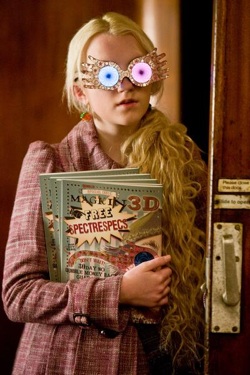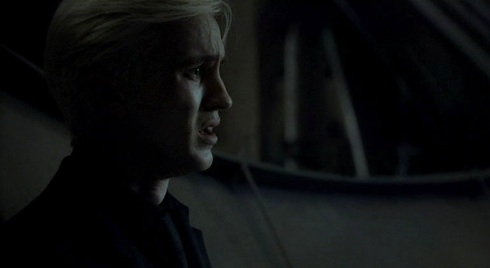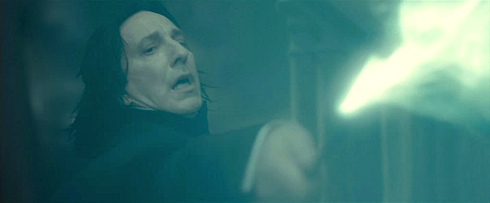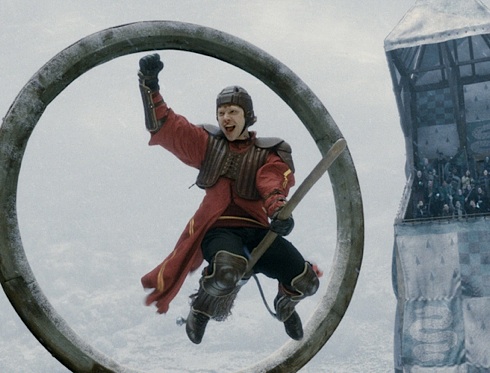This rewatch has yielded a number of surprises, reversals of initial impressions, and a reaffirmation of the awesomeness of Alan Rickman (which is kind of like renewing marriage vows: not necessary but it always feels good to remind oneself). By far the biggest surprise is, pending the release of Deathly Hallows, Part 2? That the best movie in the series is Harry Potter and the Half-Blood Prince.
Yes, that’s right. Flying in the face of the orthodoxy—frequently stated by just about everyone to whom I mention I’ve been doing this rewatch—that Prisoner of Azkaban is the only movie in the series worth a second thought, I salute Half-Blood Prince for finally hitting the right balance between rigorous fidelity to the books and making sense as a piece of cinema independent of them. It’s got some truly wonderful visual touches, in particular a gray-green color scheme employed whenever we’re in the presence of sinister forces, which evokes both the emotional coldness of Voldemort’s soul as well as the color of his house (and that of all his allies save Wormtail), Slytherin. Half-Blood Prince sees director David Yates, who joined the series in its last installment, Order of the Phoenix, hit his stride. Where Order of the Phoenix cut material from the book to the point of excess, the cuts and alterations made in Half-Blood Prince are all in the service of making a coherent movie, in which it succeeds shockingly well.

Daniel Radcliffe delivers his finest work yet as Harry. His performances in each movie have been consistently better than I remember them the first time; my initial memory was that he spent entirely too much of the movie awkwardly reacting to computer-generated effects that were added later or shouting exposition. The way a lot of the movies ended up meant that he spends a lot of time doing those things, but he has a number of beautifully natural moments in Half-Blood Prince, coming closer to candor than anything yet afforded Harry. One scene in particular, when Hermione warns Harry that some girl wants to slip him a love potion, and Harry checks her out, only to have Hermione admonish him, “She only likes you because she thinks you’re the Chosen One,” the way Harry smiles and puffs up his chest slightly and goes, “But I am the Chosen One,” earning him a swat from Hermione, I don’t care, I love that scene. It’s a sign that, sure he’s Harry Potter and he’s The Boy Who Lived and a paragon of moral rectitude and all that, but he’s still a 16 year old boy.
A number of subplots are lost in the adaptation (between Order of the Phoenix and this, the character of Tonks barely exists anymore, and all the political stuff is gone), and yet Yates and screenwriter Steve Kloves (returning to the series after a one-movie hiatus) make it feel as though it’s all there, even if in reality it isn’t. Aiding tremendously to this feel is the much-appreciated exile of Shouty Dumbledore. Michael Gambon’s take on the role still differs greatly from the way it was written by J.K. Rowling, but as long as he’s not shouting at students or throwing Harry up against walls it’s fine by me.

The acting is universally quite good, with Tom Felton in particular stepping it up as Draco Malfoy. He has more to do this time around than he sometimes has, and he’s grown into the part sufficiently that he’s up to the challenge. Helena Bonham Carter’s Bellatrix Lestrange is as charismatically loathsome as Evanna Lynch’s Luna Lovegood is enchantingly spacy (Luna Lovegood is the greatest). And boy are the kids they got to play Young Voldemort spooky. Especially the 15-16 year old one, Frank Dillane. Chills up the spine, that one.
Perhaps due to a reported $250 million budget, one of the oddest recurring themes in the Harry Potter movies, the underwhelming special effects, is absent in Half-Blood Prince. All the inky black Death Eater chemtrails almost look cool. No one has yet been able to figure out how to make Hagrid consistently proportionate to the non-half-giants in the cast, but Yates and the quarter-billion-dollar FX team come closest, and compensate for the weird forced perspectives and all with the scene when Hagrid (Robbie Coltrane) and new Potions master Horace Slughorn (Jim Broadbent, about whose performance in this I could write a book; excellent work, packed with detail) are drunkenly eulogizing the late Aragog. You can tell Coltrane and Broadbent were filmed separately and joined in afterward, but their performances and the seamless effects make it very, very hard to spot.

But enough micro-analysis of the special effects. What makes Half-Blood Prince such a surprising good time is that it sweeps the audience along in the cinematic equivalent of the book’s narrative drive, something none of the movies have yet been able to accomplish. The funny parts are really funny, the scary parts are really scary and when Snape kills Dumbledore it’s every bit as shocking, weird, and abrupt as it is in the book, which is shocking, weird, and abrupt indeed. The movie omits Dumbledore’s funeral, which is a shame, because seeing literally everybody who isn’t a Death Eater who’s still alive show up to pay tribute was immensely powerful. On the other hand, it might not have worked on screen; it’d have been about twenty minutes long, for one, and would dissipate the impact of Dumbledore’s actual death for another. The movie ends, with the image of Harry, Hermione, and Ron together, the way it has to: with our hero and his two faithful companions alone, facing what lies ahead.
Again, I’m still surprised at how good Half-Blood Prince was on second viewing. I’m not going to go completely crazy and say it’s better than the book, but it’s good enough I had to ask the question. That’s impressive, considering the quality of its screen predecessors, most of which feel like cash-ins rather than movies. Half-Blood Prince is an actual movie, and a fine one at that.
Danny Bowes is a playwright, filmmaker and blogger. He is also a contributor to nytheatre.com and Premiere.com.










